Magz Hall. Skyport. Mixed media, 2019
Skyport takes its name from the pirate radio station Skyport Radio which broadcast from a garden shed under the Heathrow flightpath between 1971 and 1979. The commission extends the artist’s enquiry into the contested nature of radio frequencies and their governance. In the skies above London private transmissions from air traffic control compete for wavelength with a range of public transmissions, both pirate and licenced, and indeed, the AM spectrum is dominated by the airport’s transmissions. While these transmissions are available for all to hear, in the UK it is both illegal to listen to them and to relay what has been heard to a third party. In defiance of these regulations, aviation enthusiasts eavesdrop on air traffic control and there is a burgeoning market for the scanning technologies that make it possible. On display for Skyport is a set of airband radios and a plasma screen showing in wave form current air traffic radio activity.
About the work :
I am interested in the contested nature of radio frequencies and their governance. In the skies above London private transmissions from air traffic control compete for wavelength with a range of public transmissions, both pirate and licenced, and indeed, the AM spectrum is dominated by the airport’s transmissions. While these transmissions are available for all to hear, in the UK it is both illegal to listen to them and to relay what has been heard to a third party. In defiance of these regulations, communities of aviation enthusiasts eavesdrop on air traffic control and there is a burgeoning market for the scanning technologies that make it possible. David Smith’s air band radio handbook (above) first published in 1986 has eight editions. On display for Skyport is a set of air band radios, which visitors can scroll through but must not listen to the air traffic. The irony being its perfectly legal to own such a radio scanner and there are some great sounds to be picked up across that band. The screen to the right shows in waveform live air traffic radio activity.
The photos and cards on display come from Skyport Radio which broadcast from a garden shed under the Heathrow flightpath from 1971 to1979 at 46 Shaftesbury Avenue, Feltham, coincidently next to Gladstone Avenue Freddie Mercury’s family home. Whilst researching pirate radio activity in the area, I found it had a rich history as the first ever national pirate radio conference happened at Heathrow. I was drawn to Skyport due to its socialist ethos and the wonderful photo documentation from the personal archive of Mark Aston, taken on a Zenith EM, with Helios lens which is old Soviet tech.
The station was listened to around the world and on display are just a few of the thousands of cards they received. The irony is not lost that listeners in Russia were keen to hear western music to get a sense of the so-called democratic freedoms in the West whilst station members sent listeners info about the Tory cuts and the miners’ strike. Former DJ Terry Anderson told me
“At the time I joined, Skyport had a left wing feel to some of its programmes, as a rebuff to the rise of the National Front and other racist organisations. In addition, much of the listenership from around the world seemed to contact the station to ‘prove’ they were listening in some far flung corner of the globe and then receive a card to add to their collection – there was a worldwide form of club for people who listened in to shortwave stations.”
“The studio was in a shed at the bottom of the garden and it was very cold indeed in winter – there was a line that ran to Mark’s bedroom back in the house from which the shows were engineered (in the sense of checking levels and so on) and recorded onto a reel-to-reel tape machine. I had complete freedom to play whatever tracks I wished, and I cherished that. Mark was a very pleasant man, and his mother was extremely kind, providing cups of tea and so on”
Mark recalls “Having grown up near the airport I have mixed feelings about it, it was a playground for us as kids in the 60’s before the tight security regulations, and it provided a career for my mother who worked for BOAC at Hatton Cross, but it also work me up most mornings around 4am when they were running up the engines of aircraft for the day.”
Mark Astons amazing photo archive can be found at http://gunfleet.com/ his website is 20 years old and is certainly worth visiting.Many thanks to the Pervasive Media Studio at the Watershed Bristol for research a research and development residency and ACE.
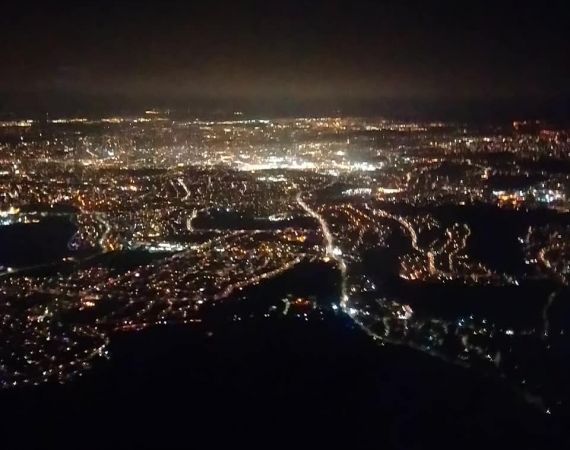
Air Matters Research Blog
Air Matters: Learning from Heathrow is a forthcoming exhibition and programme of events at Watermans Arts Centre, 8th October – 31st Dec 2019, that explores the politics of air at London Heathrow. For some, the air at Heathrow is a space of networks and travel. For others, it is what they must breathe. The conflation of diverse requirements within one locale presents a significant societal challenge that hasimplications for sustainable development, well-being, and dignity. Air Matters responds to these challenges, bringing together newly-commissioned artworks, workshops and a symposium.
The exhibition will comprise of six commissioned works by Kate Carr, Nick Ferguson, Matthew Flintham, Magz Hall, Hermione Spriggs & Laura Cooper, and Louise K Wilson. Through investigations into sound and geography we will consider how the air shapes what can be felt and performed. Through study of birds and other airborne life, we will identify competing users of the air. Through mapping patterns of movement, we will make visible aerial architectures. We will ask what art can teach us about the air
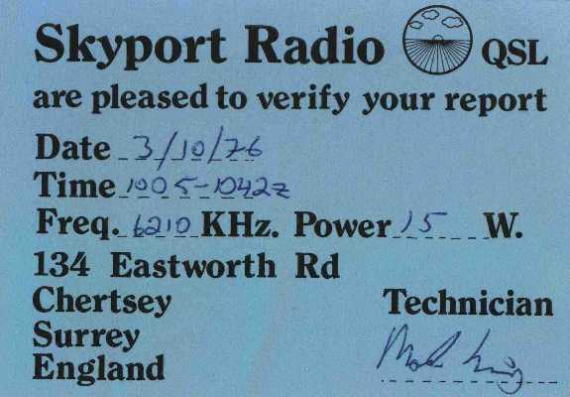
My own contribution “Skyport” named after the Heathrow based 70’s pirate station, take the form of a radio air band sound installation that exploring Heathrow, airspace across radio frequencies. I have been looking into the history of radio scanning and the areas ongoing pirate radio legacy. Which is proving to be very fascinating.
I contacted Terry Anderson who was a DJ on the SW station in the 70’s who very kindly shared with me his memories of his time at the station which was broadcast from a tiny shed near the airport runway.
Mark Aston was the founder of the station and has an amazing photo archive of the station on gunfleet.com it was located at 46 Shaftesbury Avenue, Feltham, coincidentally the next street was Gladstone Avenue home to the late Freddie Mercury.
His amazing photo archive shows how the station was listened to around the world and the thousands of QSL (reception)cards sent in by listeners. Although a music station Sky Port clearly had socialist links. Listeners were sent out info about the miners strike and the Tory cuts, a morning star poster sits behind the desk seen here. It seems the team even went on a trip to Moscow. The station stopped broadcasting in 1979 as its founders moved to FM to run a new station called Uptown Radio. Skyport actually pioneered the first Hindi Film music programme but from the outset it focused on punk music and Heavy Metal which was at first ignored by the mainstream stations something DJ Terry Anderson championed. The station ended due to improved sound and local reach offered by FM transmitters and frustrations that international listeners were more excited about sharing QL cards rather than the music.
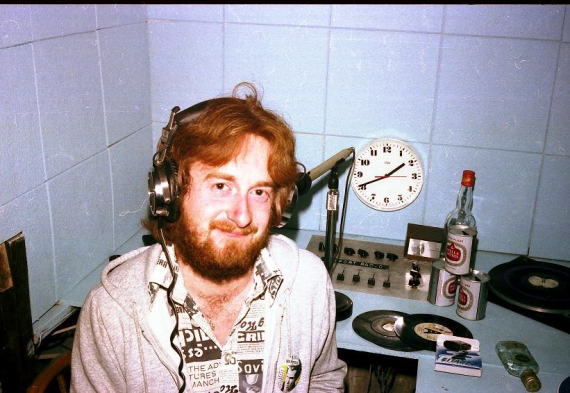
Skyport Radio – 1977/78 – Terry’s personal memories… Photo by Mark Aston
“I was asked to join Skyport by a friend (Rob), who already had a show on the station. I was aware of pirate radio having listened to the offshore stations in the 1960s, and then later the land based pirates, Radio Jackie, and Kaleidoscope Radio. Although I did think that the pirate radio stations had an exciting edge to them, the truth is I was motivated by the idea that I could play music that I loved to people listening all around the world.
At the time I joined, Skyport had (if I recall correctly) a left wing feel to some of its programmes, as a rebuff to the rise of the National Front and other racist organisations.
In addition, much of the listenership from around the world seemed to contact the station to ‘prove’ they were listening in some far flung corner of the globe and then receive a card to add to their collection – there was a worldwide form of club for people who listened in to shortwave stations.
I was less interested in this and was simply enthused to be a radio presenter, playing music that I loved. At the time, it was the growth of punk music and I played The Clash, Sex Pistols, Siouxsie & The Banshees and so on, and also added the reggae music to which I was thoroughly devoted (still am!) with artists such as Ken Boothe, Gregory Isaacs, and Sugar Minott.
It was a long time ago but this is what I recall of the circumstances: I used to take the train with Rob to Feltham and we would walk to Mark King’s house, where he lived with his mother. The shows were broadcast on a Sunday but we recorded them on (I think) a Thursday evening. The studio was in a shed at the bottom of the garden and it was very cold indeed in winter – there was a line that ran to Mark’s bedroom back in the house from which the shows were engineered (in the sense of checking levels and so on) and recorded onto (if I recall correctly) a reel-to-reel tape machine. I had complete freedom to play whatever tracks I wished and I cherished that. Mark was a very pleasant man, and his mother was extremely kind, providing cups of tea and so on.
I was never really interested in the nuts and bolts of how the station got on air. From memory I think Mark simply took the risk of broadcasting from his house on Sunday mornings. I don’t recall the station ever being raided by the authorities (maybe they weren’t so interested in shortwave stations).
The studio set up worked very well but it was basic – a couple of record decks and (I think) a cassette or cartridge player. It was very close to the runways at Heathrow and I imagine there may have been aircraft noises in the background but I don’t recall this.
The main part of the experience that I enjoyed was that it gave me a first start into broadcasting and I was given the freedom to learn on the job and from my mistakes. The least enjoyable parts were the cold in the winter months in that shed, and the fact that it was shortwave only which restricted the audience – this was what motivated all of the presenters to move to a new FM based radio station the late summer of 1978 (Uptown Radio).
I did attend some sort of ramshackle meeting of pirate radio stations in London but this was a year or two later. There is a well-known story in the history of pirate radio in that on my way home after this conference/meeting I was recognised on Waterloo station by someone from another pirate radio station that coveted our frequency – so he threatened me with a shotgun and told me I should tell everyone on our station that we should move frequency, or else…! We didn’t move and I lived to tell the tale.
I recall there was a ‘political’ station around at the time (was it Radio Enoch?) but I have no memory of it. I suspect it was notorious because of its name and intentions but probably had only a handful of listeners. At this time there was much concern about the rise of extremism and I attended many events protesting against the National Front and similar organisations – the best were those organised by Rock Against Racism; I particularly remember a great day with a march to Victoria Park in Hackney and a scorching gig in the park with X-Ray Spex, Tom Robinson, Steel Pulse, and a magnificent performance from The Clash.
I truly don’t believe that any right wing radio stations had any serious impact at that time. Shortly after Skyport, Uptown, and (I think) Thameside Radio, I moved into mainstream media and forged a career in radio, television, and film.”
A selection from Mark Aston’s Archive
Sky Scanning
Scanning has a long history, as a male dominated hobby since the invention of radio. In the UK scanners have been available commercially since the early 60’s.
Shorrock Developments Ltd in Blackburn Lancs were the first UK company to sell airband radio, costing about £36 pounds about £700 today. These radios were designed so people could listen into radio flight communications. Shorrock radios used germanium transistors which often developed a fault over time called the tin whisker effect, which caused a reaction inside the can and caused small conductive tracks to form and short the transistor junction, making component fail and hard to fix. I have a fantastic old school radio that uses germanium, that is still working and many vintage scanners still work today. Germanium, is currently experiencing a renaissance as a semiconductor material, attracting interest in the silicon tech industry. It’s perceived as a potential candidate to use well beyond the end of silicon, so its Interesting as ever to see how this part of radio radio history may still part of our digital future, so let’s get back to scanners.
Scanning air frequencies is a world-wide hobby with aviation enthusiats and has a long and mostly undocumented history. Which I am starting to address here.
I found a great photo which I have shared on my personal blog with other related pics, it shows one such group (Liverpool Echo Jan 12 1967) :”The busy midnight scene at Liverpool Airport, with a Trident from Amsterdam in the centre. It was a bumper occasion for these members of the Merseyside Society of Aviation Enthusiasts” Clearly one of the men is holding a large radio receiver and a not very portable one at that.
Heathrow aviation society is 52 years old and in recent years its volunteers have been enlisted to help combat terrorism. Plane-spotters can now apply for identity cards and a code of conduct encouraging them to report anything suspicious. Scotland Yard backs the scheme, introduced by aviation enthusiasts’ club LAAS International. The BBC reported “Aviation enthusiasts are watching the activities of the airport every day and their legitimate interest can only be to our advantage”.
Owning a scanner is not illegal, however listening in is, although it seems rare to be prosecuted for it in the UK and it hasn’t stopped an industry growing up around it or the many now online groups who share advice and support.
Abroad there have been serious legal ramifications for the hobby in November 2001, fourteen aircraft spotters mostly British apart from two Dutch, were arrested at an open day at a Green air base in Kalamata. They were charged with espionage and faced 20-year prison sentences if found guilty. After six weeks in prison they were released and the charges reduced to the charge of illegal information collection. At the trial in April 2002 they were stunned to be found guilty, with eight of the group sentenced to three years, the rest for one year. They appealed and were acquitted a year later.
Digital encryption of services and the ability to use sites which map out planes flights does mean there is a lot less to listen to which means the hobby is in decline.The internet is now a bit of a grave yard for past activity, its full of discussion boards, tips and videos of how to use them and they were certainly popular with the older generation. Scanners enthusiasts have always managed to keep a low profile. A quick search and you can find tons of related guides and directories, as its legal to own a scanners in the UK but not legal to listen to it. Which meant it’s really been impossible for anyone to enforce and stop people doing it in personal spaces.
Some may recall the artist Scanner, who took his name from the police device, he made music from telephone calls which could be picked up from a police scanner, these days only some of the very old cordless phones can still be picked up.
Scanners pick up parts of the radio spectrum reserved for other uses outside of conventional radio, shipping, CB etc however all of the key emergency services have now moved to digital and are encrypted but it seems there are still signals to pick up across the spectrum with modern day devices: marine, aircraftbut and other local uses perhaps less exciting to those looking for some drama.
Aviation uses AM radio frequencies rather than FM as it allows more than one signal to come through and doesn’t block so distress signals can be heard even if pilots are on the same frequency.
I found a US radio hack to turn your FM radio in to a scanner so I had a go trying to make a few old sets into scanners and enlisted Dan at Tinkersonic to lend a hand. It worked in terms of moving the radio off the dial and on to the higher frequencies but sadly didn’t pick up anything to listen to in the wilds of Kent, but I want to try again with a better radio in a better location. Anyhow here are some of the photos I took of the radios hacked open and modified, which looked great just didn’t sound very exciting.
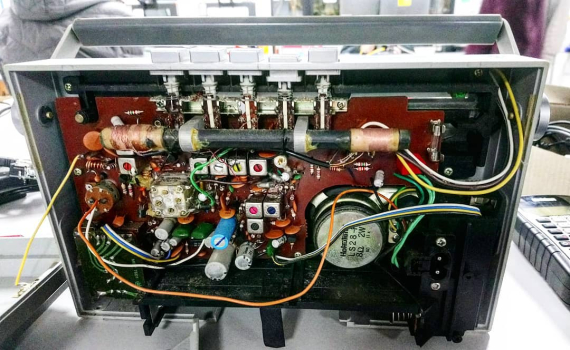
I also discovered a man, who has just started his own radio spy museum in his shed in Dover and has put me contact with experts who currently work in the radio communications industry, they work for ICOM who sell some serious kit and know loads about radio tech and agree the golden age of the radio scanning craze is over and they sell them, among other large scale radio telecommunications devices for air land and sea which are still very much in demand.
I want my installation work to highlight how much radio activity still happens across the spectrum in the Heathrow area, past and present and so my next port of call on the blog will look at drones and how radio is used to disable them.
Drone Defenders
Known in the industry as UAVs, drones are aircraft piloted by remote control or onboard computers. Recent airport closures have taken me to look at how radio technology is being used to combat drones.
The recent drone disruptions at Heathrow and Gatwick airports highlighted the airports were not prepared and lacked high-powered radio devices to disable unwanted drones. I am looking into wireless technology used in Heathrow airspace and this is certainly a topical area to explore.
The Civil Aviation Authority (CAA) have documented numerous cases of drones flying dangerously close to airports and aircraft, resulting in several near-collisions. The UK Airprox Board list 120 near misses at airports between drones and aircraft in the last year, which is up 29 per cent on 93 in the whole of 2017, and just six recorded incidents in 2014.Clearly, the use of domestic drones is becoming a growing problem in the aviation world.
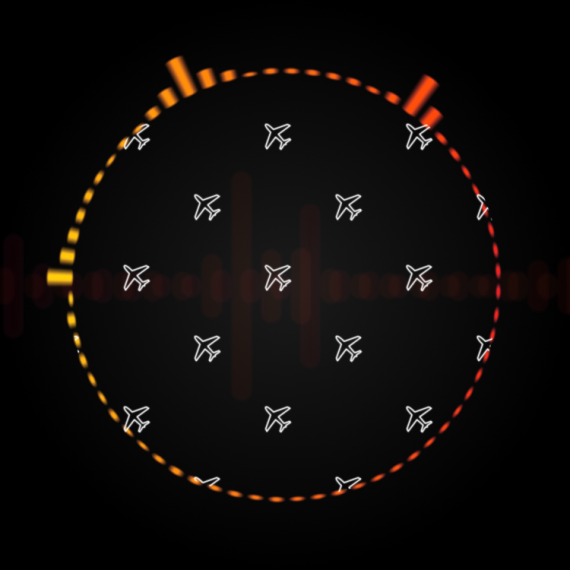
Ministers have decided to widen existing no-fly zones to try to prevent more drone chaos and flying drones within 5km (3.1 miles) of an airport is to be outlawed. Heathrow Airport’s local council has already effectively prohibited the flying of drones anywhere within the borough’s public spaces.
The Airport Operators Association have stated that it is currently testing and experimenting with different drone defence systems but has not said which ones. So I have been looking at the some of the devices that are being used to disable drones.
Drone jammers disrupt the most popular GPS and ISM radio frequencies, which guide drones in the air, then take control and guide the drone safely down. Drone Defender is one such device, produced by Battelles in the USA, which emits an electromagnetic field. It’s not currently available for consumer use and is awaiting authorization from the Federal Communications Commission.
https://www.youtube.com/watch?v=esvkhadl6nI
SKYPERION is a UK company who provide drones detection to help protect airports against potential collisions. This system uses radio frequency and electro optic sensors around Airport perimeters, to detect drones. They can distinguish drones from other sources and send alerts when one is detected. Their website states they identify drone activity by:
o Geolocating signals associated with drone activity
o Notifying security staff of location and direction of the drone, preserving data from the alert
o Providing early warning to facilitate quick mitigation action
o Capturing and retaining alert data for use as digital evidence in legal cases
o Geolocate signals associated with the handset!
http://metisaerospace.com/skyperion-counter-uav/
Jane’s reported that the MOD had purchased what they called the “Drone Dome”, a counter-unmanned aircraft system (C-UAS) made by Rafael, which has radar detection, electro-optical (EO) identification and communication jamming, but the laser weapon option would not be included. Its RF jamming capability provides a “soft-kill” functionality, which causes the drone to fly out of control, however Warfare Today reported that it did not arrive in time for the recent UK airport issues.
It’s been suggested that instead of the Drome Dome Heathrow are now likely to be using a million pound Anti-UAV Defence System (AUDS) “developed by a consortium of three British companies. Horsham-based Chess Dynamics who have developed the electro-optic tracking system, Saffron Waldon-based Blighter Surveillance Systems who added electronic-scanning radar target detection, and Enterprise Control Systems, in Wappenham, who provide radio frequency disruption technology.” (Warfare Today).
AUDS remotely detects and disables intruder drones and tracks their operators byscanning the skies for drones and jams their control signals, using high-powered radio signals. The jammer range is around 500 to 1500 meters which is the height flying limit for drones. Once the jamming device is on, drones flying around in the area are forced to drop.
Clearly there are current legal issues with using such technology in public spaces and legislation to use them is not yet in place.
It’s not clear which system Heathrow have gone for and how they will disable the drones to the ground. Unsurpsingly, suppliers were very tight lipped about it when I contacted them. Drone defence is clearly expensive and highly regulated for military use, but this hasn’t stopped US hackers working out how to disable and take over drones by hacking into computer systems and then sharing videos on the net.
At the DEFCON hacker conference in Las Vegas, David Jordan of Aerial Assault demonstrated hacking tech that can break into computer networks by scanning for unsecured networks, recording their locations using GPS and relaying the information to the pilot taking away control.






























You must be logged in to post a comment.